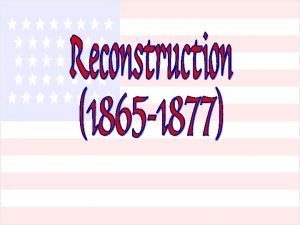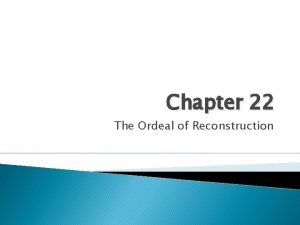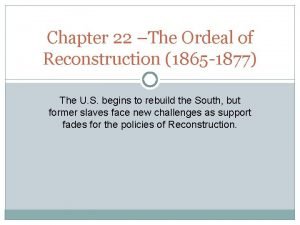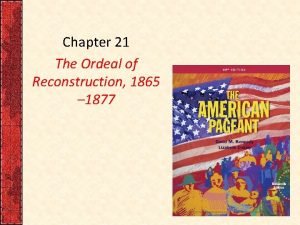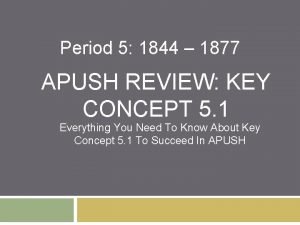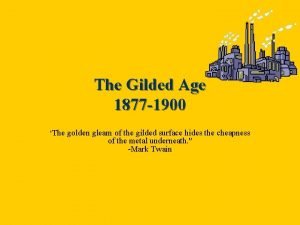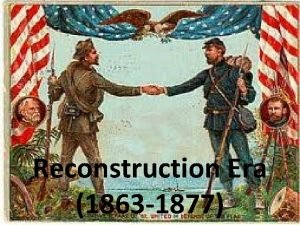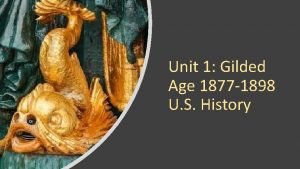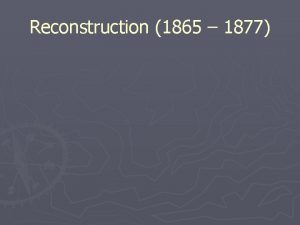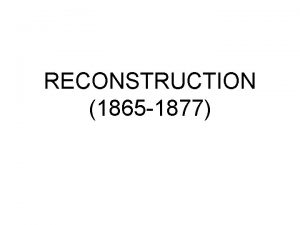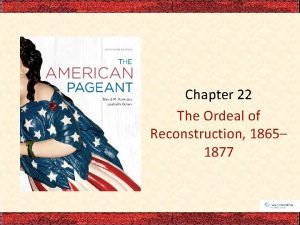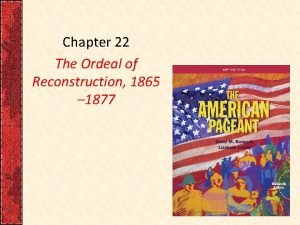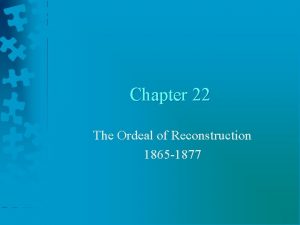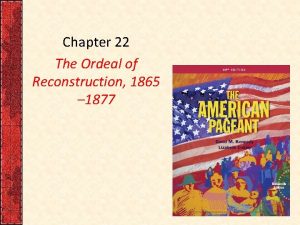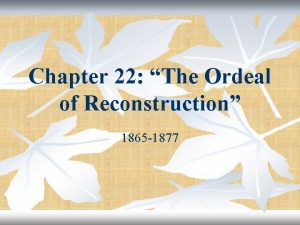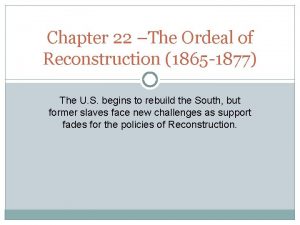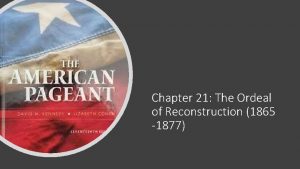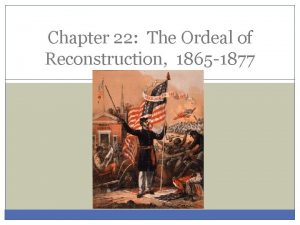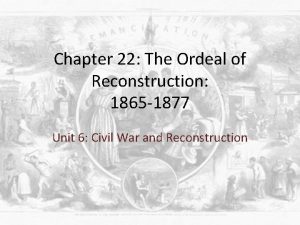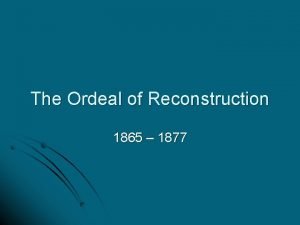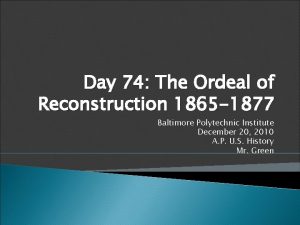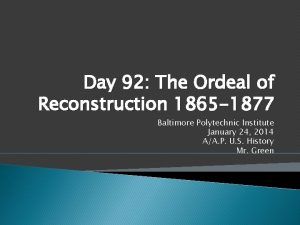The Ordeal of Reconstruction 1865 1877 Chapter 22





















- Slides: 21

The Ordeal of Reconstruction 1865 -1877 Chapter 22 AMH 2020 Derek Wingate

Themes • How was the South to be rebuilt? • Free Blacks • How was the South going to be reintegrated into the Union?

Freedmen Define Freedom • Freed Blacks faced a very confusing situation - many were re-enslaved once the Union armies had left the area. - Other slave owners used legal means. • Some slaves loyally stuck by their masters, while other let out their pent up frustrations and pillaged their former masters land. • Tens of thousand of freed blacks took to the road in search of work or to look for loved ones. • The Church became the focus of the Black community.

The Freedman’s Bureau • The Freedman’s Bureau was created by Congress in 1865 - to help newly freed black cope with the reality of freedom. - headed by Gen. Oliver O. Howard. • Its greatest success was teaching 200, 000 Blacks to read. • The Bureau’s other achievements were meager in comparison such as settling former slaves on 40 acres. • White Southerners hated the Bureau and it expired in 1872 after only seven years.

Andrew Johnson • Johnson apprenticed tailor who came from very poor and humble background. • He served in Congress for many years and was the only Confederate congressman not to leave Congress when the South seceded. • He championed the cause of poor whites over the planter aristocracy. • He doggedly defended states rights and the constitution. • However, he did not understand the North and was distrusted by the South. Hotheaded contentious and stubborn. • He was the wrong man at wrong place at the wrong time.


Presidential Reconstruction • Abraham Lincoln believed that the South had never legally withdrawn from the Union. • His plan for restoring the Union, was called the Ten Percent Plan: - 10% of its voters had to take an oath and pledge loyalty to the union. - acknowledge the emancipation of slaves. • Lincoln’s plan was very forgiving of the South.

Presidential Reconstruction • Lincoln’s plan provoked a sharp reaction among the Republicans, who were split into groups, moderate and radical. • Moderate Republicans agreed with Lincoln’s plan to swiftly and painlessly restore the seceded states to the Union. • The Radical Republicans believed the South should painfully atone for their sins. • In response to The 10% Plan, the radicals rammed the Wade-Davis Bill through Congress. • The Wade-Davis Bill called for 50% of voters to take oaths of allegiance stronger safeguards for emancipated slaves.

The Black Codes • In order to control freed blacks, many Southern states passed Black Codes. • These laws were meant to keep the Black population in submission and workers in the field. • Blacks were not allowed to jump their labor contracts at the risk of penalties and fines. • The codes forbade blacks from serving on juries. Idleness was a punishable offence. • Blacks were not “slaves” on paper, but in reality, their lives were little different.

Congressional Reconstruction • Reappearance of former rebels in Congress by December 1865. • This disgusted the Republicans, who with the Democrats from the South had passed numerous bills that favored the North. • The Republicans were alarmed that the South was more powerful politically than before because slaves were counted as one person not 3/5 ths. • The Southern states picked up 11 congressional votes and 11 electoral votes. • On December 6, 1865, President Johnson declared the Union restored.

Johnson clashes with Congress • President Johnson continually vetoed Republican backed bills which led to a contentious relationship. • However, in February 1866, it exploded out into open when Johnson vetoed a bill (later repassed) extending the life of the Freedmen's Bureau. • In retaliation, the Republicans passed the Civil Rights Bill which gave American citizenship to freed blacks. Johnson vetoed it. • However, the Republican led Congress overrode his vetoes from here on out. • Johnson was called “Sir Veto” or ‘the dead dog in the White House”

The Fourteenth Amendment • In the 14 th Amendment, the Republicans sought to instill the same ideas of the Civil Rights Bill: • (1) all Blacks were American citizens. • (2) if a state denied citizenship to Blacks, then its representatives in the Electoral College were lowered. • (3) former Confederates could not hold federal or state office. • (4) the federal debt was guaranteed while the Confederate one was repudiated (erased).


Republican Principles and Programs • By 1866, the Republicans had a veto-proof Congress and nearly unlimited control over Reconstruction. • In the Senate, the leader of the radicals was Charles Sumner, and in the House, the radical leader was Thaddeus Stevens. • 3. The radicals wanted to keep the South out of the Union as long as possible and totally change its economy and the moderates wanted a quicker Reconstruction. What happened was a compromise between the two extremes.

Reconstruction By the Sword • The Reconstruction Act of March 2, 1867 divided the South into five military zones, temporarily disfranchised tens of thousands of former Confederates, and laid down new guidelines for the readmission of states • All states had to approve the 14 th Amendment, making all Blacks citizens. • All states had to guarantee full suffrage of all male former slaves. • The 15 th Amendment, passed by Congress in 1869, gave Blacks their right to vote.


The Realities of Radical Reconstruction in the South • Women suffrage advocates were disappointed by the 13 th, 14 th, and 15 th Amendments, since they didn’t give women suffrage. - Elizabeth Cady Stanton and Susan B. Anthony. • Blacks began to organize politically, and their main vehicle was the Union League. • Black men also began to hold political offices, as men like Hiram Revels and Blanche K. Bruce served in Congress. • Scalawags, Southerners who were accused of plundering Southern treasuries and selling out the Southerners, and “carpetbaggers, ” Northerners accused of parasitically milking power and profit in a nowdesolate South. • Ku Klux Klan


Johnson Walks the Impeachment Plank • Radical Republicans were angry with President Johnson, and they decided to try to get rid of him. • In 1867, Congress passed the Tenure of Office Act, which provided that the president had to secure the consent of the Senate before removing his appointees once they had been approved by the Senate (one reason was to keep Edwin M. Stanton, a Republican spy, in office). • However, when Johnson dismissed Stanton early in 1868, the Republicans impeached him.

A Not-Guilty Verdict for Johnson • Johnson was not allowed to testify by his lawyers, who argued that the Tenure of Office Act was unconstitutional and Johnson was acting under the Constitution, not the law. • On May 16, 1868, Johnson was acquitted of all charges by a single vote, as seven Republican senators with consciences voted “notguilty” (interestingly, those seven never secured a political office again afterwards). • 3. Die-hard radicals were infuriated by the acquittal, but many politicians feared establishing a precedence of removing the president through impeachment.

The Purchase of Alaska • In 1867, Secretary of State William H. Seward bought Alaska from Russia to the United States for $7. 2 million, but most of the public jeered his act as “Seward’s Folly” or “Seward’s Ice-box. ” • Only later, when oil and gold were discovered, did Alaska prove to be a huge bargain.
 1877-1865
1877-1865 Chapter 22 the ordeal of reconstruction
Chapter 22 the ordeal of reconstruction Chapter 22 the ordeal of reconstruction
Chapter 22 the ordeal of reconstruction Ordeal chapter 22
Ordeal chapter 22 Ordeal chapter 21
Ordeal chapter 21 Industrialization 1865 to 1901
Industrialization 1865 to 1901 Supreme ordeal in the odyssey
Supreme ordeal in the odyssey Trial by ordeal definition
Trial by ordeal definition Ordeal by cheque activity
Ordeal by cheque activity Supreme ordeal definition
Supreme ordeal definition Ordeal by cheque assignment answer key
Ordeal by cheque assignment answer key Ordeal by cheque interpretation
Ordeal by cheque interpretation Georgia history timeline 1877-1919
Georgia history timeline 1877-1919 Joseph pulitzer apush
Joseph pulitzer apush Apush period 5 key concepts
Apush period 5 key concepts Compromise of 1877
Compromise of 1877 Gilded age strikes
Gilded age strikes Whats the compromise of 1877
Whats the compromise of 1877 1877 golden 1
1877 golden 1 Tanssija 1877-1927
Tanssija 1877-1927 Define compromise of 1877
Define compromise of 1877 The gilded age 1877 to 1898 worksheet answers
The gilded age 1877 to 1898 worksheet answers
